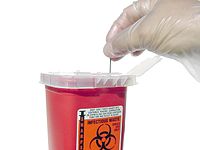Biological hazard

Biological hazards, also known as biohazards, refer to biological substances that pose a threat to the health of living organisms, primarily that of humans. This can include medical waste or samples of a microorganism, virus or toxin (from a biological source) that can affect human health. It can also include substances harmful to animals.
The term and its associated symbol are generally used as a warning, so that those potentially exposed to the substances will know to take precautions. The biohazard symbol was developed in 1966 by Charles Baldwin, an environmental-health engineer working for the Dow Chemical Company on the containment products.[1][2]
It is used in the labeling of biological materials that carry a significant health risk, including viral samples and used hypodermic needles.
In Unicode, the biohazard symbol is U+2623 (☣).
Classification
Bio hazardous agents are classified for transportation by UN number:[3]
- Category A, UN 2814- Infectious substances affecting humans and animals: An infectious substance in a form capable of causing permanent disability or life-threatening or fatal disease in otherwise healthy humans or animals when exposure to it occurs.
- Category B, UN 2900- Infectious substances affecting animals only: An infectious substance that is not in a form generally capable of causing permanent disability of life-threatening or fatal disease in otherwise healthy humans and animals when exposure to themselves occurs.
- Category B, UN 3373- Biological substance transported for diagnostic or investigative purposes.
- Regulated Medical Waste, UN 3291- Waste or reusable material derived from medical treatment of an animal or human, or from biomedical research, which includes the production and testing of biological products.
Levels of biohazard

The United States' Centers for Disease Control and Prevention (CDC) categorizes various diseases in levels of biohazard, Level 1 being minimum risk and Level 4 being extreme risk. Laboratories and other facilities are categorized as BSL (Biosafety Level) 1-4 or as P1 through P4 for short (Pathogen or Protection Level).
- Biohazard Level 1: Bacteria and viruses including Bacillus subtilis, canine hepatitis, Escherichia coli, varicella (chicken pox), as well as some cell cultures and non-infectious bacteria. At this level precautions against the biohazardous materials in question are minimal, most likely involving gloves and some sort of facial protection.
- Biohazard Level 2: Bacteria and viruses that cause only mild disease to humans, or are difficult to contract via aerosol in a lab setting, such as hepatitis A, B, and C, influenza A, Lyme disease, salmonella, mumps, measles, scrapie, dengue fever. "Routine diagnostic work with clinical specimens can be done safely at Biosafety Level 2, using Biosafety Level 2 practices and procedures. Research work (including co-cultivation, virus replication studies, or manipulations involving concentrated virus) can be done in a BSL-2 (P2) facility, using BSL-3 practices and procedures.
- Biohazard Level 3: Bacteria and viruses that can cause severe to fatal disease in humans, but for which vaccines or other treatments exist, such as anthrax, West Nile virus, Venezuelan equine encephalitis, SARS virus, tuberculosis, typhus, Rift Valley fever, HIV, Rocky Mountain spotted fever, yellow fever, and malaria. Among parasites Plasmodium falciparum, which causes Malaria, and Trypanosoma cruzi, which causes trypanosomiasis, also come under this level.
- Biohazard Level 4: Viruses and bacteria that cause severe to fatal disease in humans, and for which vaccines or other treatments are not available, such as Bolivian and Argentine hemorrhagic fevers, Marburg virus, Ebola virus, hantaviruses, Lassa fever virus, Crimean–Congo hemorrhagic fever, and other hemorrhagic diseases. Variola virus (smallpox) is an agent that is worked with at BSL-4 despite the existence of a vaccine. When dealing with biological hazards at this level the use of a positive pressure personnel suit, with a segregated air supply, is mandatory. The entrance and exit of a Level Four biolab will contain multiple showers, a vacuum room, an ultraviolet light room, autonomous detection system, and other safety precautions designed to destroy all traces of the biohazard. Multiple airlocks are employed and are electronically secured to prevent both doors opening at the same time. All air and water service going to and coming from a Biosafety Level 4 (P4) lab will undergo similar decontamination procedures to eliminate the possibility of an accidental release.
Symbol
The biohazard symbol was developed by the Dow Chemical Company in 1966 for their containment products.[2] According to Charles Baldwin,[2] an environmental-health engineer who contributed to its development: "We wanted something that was memorable but meaningless, so we could educate people as to what it means." In an article he wrote for Science in 1967,[4] the symbol was presented as the new standard for all biological hazards ("biohazards"). The article explained that over 40 symbols were drawn up by Dow artists, and all of the symbols investigated had to meet a number of criteria:
- (1) Striking in form in order to draw immediate attention;
- (2) Unique and unambiguous, in order not to be confused with symbols used for other purposes;
- (3) Quickly recognizable and easily recalled;
- (4) Easily stenciled;
- (5) Symmetrical, in order to appear identical from all angles of approach;
- (6) Acceptable to groups of varying ethnic backgrounds.
The chosen symbol scored the best on nationwide testing for memorability. [5]
The design was first specified in 39 FR 23680 but was dropped in the succeeding amendment. However, various US states adopted the specification for their state code.[6]
See also
- Biological agent
- Biosafety level
- Planetary protection and Interplanetary contamination
- Public health
References
Notes
- ^ "Symbol Making" (PDF). New York Times Magazine. November 18, 2001.
- ^ a b c "Biohazard Symbol History".
- ^ USDA Policies and Procedures on Biohazardous Waste Decontamination, Management, and Quality Controls at Laboratories and Technical Facilities
- ^ http://www.iconglobe.net/blog/2011/01/07/biohazard-symbol-history/
- ^ Baldwin, CL (Oct 13, 1967). "Biohazards symbol: development of a biological hazards warning signal" (PDF). Science. 158 (798): 264–5. Bibcode:1967Sci...158..264B. doi:10.1126/science.158.3798.264. PMID 6053882. Retrieved 29 August 2011.
{{cite journal}}: Unknown parameter|coauthors=ignored (|author=suggested) (help) - ^ WAC 296-800-11045, see PDF for a high resolution graphic
Bibliography
- Baldwin CL, Runkle RS (October 1967). "Biohazards symbol: development of a biological hazards warning signal". Science. 158 (3798): 264–5. Bibcode:1967Sci...158..264B. doi:10.1126/science.158.3798.264. PMID 6053882.
- Preston, Richard (1994). The Hot Zone. New York: Anchor Books. ISBN 3-426-77257-4.
- Preston, Richard (2002). The Demon in the Freezer: A True Story. ISBN 0-375-50856-2.
External links
- "Biosafety in Microbiological and Biomedical Laboratories", official CDC guide.
- "Prevention of Biological Hazards", EU-OSHA
- "Symbol Making", an account of the development of the symbol in 1966.
- "BioSeal Systems", Biosafety level 4 containment.
